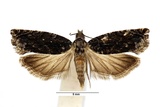Epinotia nisella (Clerck, 1759) Species
Last modified: Nov. 24, 2025, 1:25 p.m.
A common species throughout Belgium.
Details
- Classification
- Family: Tortricidae > Subfamily: Olethreutinae > Tribus: Eucosmini > Genus: Epinotia > Species: Epinotia nisella
- Vernacular names
- Variabele oogbladroller (NL), Grey Poplar Bell, Brindled Poplar Tortrix (EN), Pappel-Kätzchenwickler (DE)
- Synonyms
- Epinotia petrana (Hübner, 1813) and Epinotia siliceana (Hübner, 1813)
- First mention in Belgium
- De Sélys-Longchamps E. 1844. Énumération des insectes Lépidoptères de la Belgique. — Mémoires de la Société royale des Sciences de Liége 2: 1–35. On page 21.
- Status
-
Native
Distribution
Imago
Wingspan 12–17 mm. A very variable species with many variations which intergrade.
Some forms:
form nisella: black, fulvous or ferruginous dorsal blotch from basal patch to pre-tornal area, variable in shape and definition.
form pavonana: dorsal blotch extends into the basal patch and to the tornus.
form decorana: median fascia obsolete, whole median area overlaid with fulvous or ochreous-brown.
form cinereana: grey, without a solid dorsal blotch - identical in external appearance to Epinotia cinereana.
Bionomics
The larvae prefers catkins, also the fallen ones, but also live between two leaves spun together. Pupation takes place in the larval habitation or between leaf-litter on the ground. The species hibernates in the egg stage.
The adults are mainly active at dusk and later come to light.
Flight periods
The adults fly from late May till late October, but most observations during August.
Observed on
- Host plant (genera):
- Salix
The larva lives on Salix, and occasionally on Populus.
Habitat
It inhabits areas where the larval foodplant is common like woodland, parks and gardens, boggy heaths and banks of rivers and streams.














